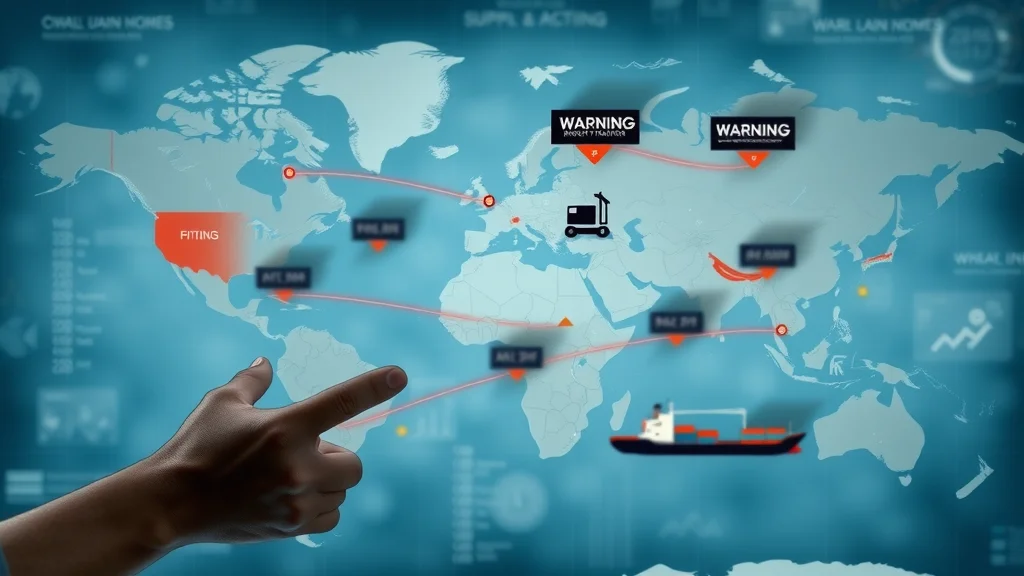Did you know that 75% of global companies have faced supply chain disruptions in just the past three years? As trade wars, pandemics, and geopolitical shifts shake the foundations of international commerce, businesses are discovering the hard way that relying on a single supplier or region can spell disaster. In today’s fast-changing global market, supply chain diversification is no longer just a best practice—it's a survival strategy. This article explores how diverse sourcing not only reduces risk but also builds long-term resilience, keeping businesses agile when the next crisis hits.
A Startling Look at Supply Chain Risk: The Case for Supply Chain Diversification
"A single disruption can cripple a business—not because the chain is long, but because it's brittle."
The modern supply chain faces threats that are more varied and impactful than ever before. Recent events have shown that risk isn’t just about lengthening a chain; it's about mitigating brittle points of failure. When international trade is disrupted by natural disasters or political tensions, businesses that rely on a single supplier or region find themselves at a loss, unable to meet commitments or serve customers. Chain risk is amplified by over-dependence, while lean inventory models and global logistics pressures make supply chain risk more acute.
Increasingly, analysts agree that supply chain diversification—the process of spreading sourcing, manufacturing, and logistics across multiple partners, geographies, and platforms—is the only way to reduce risk and ensure ongoing operations. In the United States, the reality became painfully clear as companies faced supply shock due to the Covid-19 pandemic, trade wars, and transportation bottlenecks. A strategic approach to chain management now demands that companies diversify to survive both expected and unexpected challenges in the global supply chain.

What You'll Learn About Supply Chain Diversification
The critical risks facing supply chains today
The advantages of supply chain diversification
How chain diversification boosts supply chain resilience
Strategies for implementing diversified supply chains
Opinions and insights from supply chain experts
The Current Landscape of Global Market Risks in Supply Chains
Supply chain disruptions have become routine headlines, starkly illustrating that no single region or supplier is immune to the volatility of the global market. Trade tensions between the United States and China, ongoing conflicts, and climate-related disasters have highlighted the weaknesses in global supply chains. As global supply chain complexity grows, the likelihood of chain disruptions increases, making effective risk management more important than ever.
This environment demands a fundamental shift in how businesses approach their supply chain strategies. Traditional models that focus solely on cost-efficiency and streamlined logistics leave organizations vulnerable to even minor shocks. Instead, diversifying your supply chain—by introducing multiple suppliers, alternate logistics routes, and regionalized production—helps build a more flexible structure with a stronger risk profile. In turn, this proactive approach enables companies to adapt quickly to sudden changes and mitigate risk before it impacts their bottom line.
Real-world events have repeatedly demonstrated the importance of supply chain resilience. For instance, the closure of major transport hubs can serve as a wake-up call for organizations to reassess their risk strategies—explore how the Heathrow Airport closure highlighted vulnerabilities and prompted new approaches to supply chain resilience.
How Recent Events Have Shaped Supply Chain Diversification Needs
Major global events have fundamentally altered the risk profile of international trade and supply chain management. The rapid spread of the Covid-19 pandemic, sudden imposition of trade tariffs, and unforeseen logistics obstacles like the Suez Canal blockage have each triggered massive chain disruptions. Companies relying on a single supplier or sourcing heavily from one region found their operations stalemated—with backlogs, shortages, and spiraling costs. These events have amplified the need for every business—whether multinational or local—to adopt chain diversification as a non-negotiable element of their risk management strategy.
In contrast, organizations with a diversified supply chain response were able to shift sourcing, absorb logistical delays, and continue production, albeit sometimes with higher costs or minor inefficiencies. The ability to pivot, rebalance inventory levels, and draw on a network of alternate partners underscored the critical value of supply chain diversification. Businesses across sectors are now revisiting their supplier maps, investing in technology for better chain management, and developing contingency plans as part of ongoing operational resilience measures.
Recent Global Events Impacting Supply Chains |
||
Recent Global Events Impacting Supply Chains |
Traditional Model Impact |
Diversified Model Impact |
|---|---|---|
Tariffs |
Significant disruption |
Greater resilience |
Pandemics |
Critical shortages |
Lower risk |
Geopolitical Shifts |
Trade bottlenecks |
Flexible sourcing |
Why Supply Chain Diversification Matters More Than Ever
Today, with the frequency and severity of chain disruptions rising, supply chain diversification is a fundamental concern for any business seeking to compete in or with the global market. It is no longer enough to squeeze margins through cost-cutting and lean operations; organizations must prepare for the unpredictable. History has shown again and again that companies who invest in a diversified supply network are those who recover fastest—and often even gain market share—when the inevitable crisis strikes.
Managing supply chain risk means going beyond insurance or contingency funds. It means preemptively designing operations so a blocked trade route, supplier bankruptcy, or regional disaster does not bring down the entire enterprise. Resilience, not just cost-efficiency, is the new marker of supply chain excellence. By integrating chain diversification into core strategy, businesses position themselves to navigate an environment of chronic uncertainty with confidence and agility.
Lessons Learned from Supply Chain Disruptions
Covid-19 pandemic shutdowns
Ever Given Suez Canal blockage
US-China trade tensions
The Covid-19 pandemic sent shockwaves through almost every industry’s supply chain, revealing just how vulnerable highly concentrated sourcing models were to sudden disruption. The Ever Given Suez Canal blockage created a cascading effect, holding up billions in global trade and proving how a single point of failure can lead to days or even weeks of lost revenue. Meanwhile, escalating trade tensions and tariffs between the United States and China have forced businesses to reconsider their supply chain management and look for alternative paths to reduce risk and regain stability.
Such disruptions have also taught companies the value of cultivating multiple suppliers and amplifying chain flexibility. Businesses that moved quickly to add redundancy to their sourcing and logistics options managed to sustain their operations and meet customer expectations, even if at a higher cost. These lessons underscore why chain diversification isn’t just a recommendation—it’s a proven and necessary strategic approach for risk management in today’s interconnected marketplace.

How Supply Chain Diversification Improves Chain Resilience
A resilient supply chain is one that bends but rarely breaks. Supply chain diversification fundamentally enhances chain resilience by spreading bets across geographies, suppliers, and modes of transport. When built with flexibility in mind, such a chain can quickly reroute, shift sourcing, or ramp up operations in less affected regions, thus maintaining critical flows and meeting market demand. Diversifying your supply chain is the cornerstone of modern risk management, protecting against localized disruption and systemic shocks in the global supply chain.
By carefully mapping vulnerabilities, investing in alternative relationships, and deploying technology to rapidly assess and respond to threats, organizations empower themselves to survive and thrive. Not only does this approach mitigate supply shock, but it also strengthens the company's standing with customers, investors, and regulators who increasingly demand stability and continuity, regardless of external volatility. With global supply chains under increasing pressure, only those prepared with a proactive strategy will avoid becoming headlines in the next crisis.
The Mechanics of Building Resilient Supply Chains
Establishing multiple suppliers
Regionalizing production and sourcing
Using diversified logistics networks
Continuous risk assessment
Each of these strategies is a pillar of effective supply chain diversification. Start by auditing your current supply and logistics ecosystem for single points of failure. Source from a range of suppliers, ideally across different regions, to insulate your chain from localized disruptions. Adopt advanced analytics and digital tools to monitor real-time risks, reallocate resources, and keep your risk profile current. Over time, this framework provides a durable buffer against the unexpected—whether it’s a natural disaster in one country or a political upheaval in another. Ultimately, robust chain resilience is not built in a day; it's the product of ongoing evaluation, investment, and adaptation to the global market's ever-changing landscape.
Chain Diversification vs. Cost-Efficiency: Finding the Balance
"Resilience may require investment, but the cost of recovery far outweighs the upfront spend."
Some business leaders worry that diversifying your supply chain might compromise short-term profitability. Indeed, adding suppliers, developing regional hubs, and investing in new logistics networks involve upfront costs that single-source models often avoid. However, such a view overlooks the damage caused by prolonged outages, missed deadlines, lost customer trust, and regulatory penalties—all of which can obliterate perceived savings overnight. It’s worth remembering that supply chain resilience is about more than insurance; it's about survival and long-term growth.
Balancing cost and resilience requires a strategic approach. Segment your products and prioritize mission-critical components for deeper diversification, while maintaining more traditional models for low-risk items. The most effective organizations combine rigorous cost analysis with a pragmatic risk assessment, investing where the risks of non-delivery or disruptions could have catastrophic effects on operations or reputation. In practice, the enduring value of a diversified supply chain is realized not only in preventing losses but also in the ability to capitalize on emerging opportunities as competitors struggle to recover.
Cost vs. Benefit of Diversified Supply Chains |
||
Model |
Short-term Cost |
Long-term Benefit |
|---|---|---|
Single-source |
Low |
High risk |
Diversified supply chain |
Moderate |
Lower risk, improved stability |

Case Studies: Successful Supply Chain Diversification in Action
Example 1: Electronics Giant Adopts Diversified Supply Chains

One electronics industry leader—faced with rising tariffs, growing global demand, and increasing natural disaster risk—became a pioneer in supply chain diversification. By establishing production facilities in Southeast Asia, Mexico, and Eastern Europe, as well as negotiating contracts with multiple suppliers for critical components, they created a network capable of withstanding shocks. During pandemic shutdowns and trade bottlenecks, they quickly shifted output between sites, meeting surging demand while competitors struggled with backlogs. Their resilient supply chain allowed for agility and preserved market share, showing how smart investment in chain diversification pays off even when costs rise temporarily.
This approach also leveraged diversified logistics partnerships, using sea, air, and rail to ensure continuity across regions. The result was a robust infrastructure that adapted quickly to everything from supply chain disruptions caused by raw material shortages to evolving consumer trends. Their experience highlights why every business with exposure to the global supply chain should develop a diversified, flexible network if they want to reduce risk and maintain supply chain excellence.
Example 2: Apparel Leader and Global Market Adaptation
One global apparel brand with supply bases previously concentrated in a single Asian hub has since diversified its chain by sourcing from Central America, Africa, and near-shore partners. This not only reduced exposure to regional labor or political disruptions but shortened lead times for North American and European market launches. When Covid-19 struck, forcing temporary closures at their primary Asian facility, alternative suppliers in other regions ramped up rapidly, keeping shelves stocked and the business running. Strategic chain diversification, coupled with advanced inventory tracking and flexible fulfillment, enabled them to mitigate risk, strengthen supply chain resilience, and maintain consumer confidence during the most volatile market period in a generation.
Their case underscores that supply chain diversification provides an essential buffer, enabling companies to adapt to changing global market conditions, regulatory requirements, and shifting transportation dynamics. Other sectors, from pharmaceuticals to automotive, are now following their lead, demonstrating the universal value of diversified supply chains in an unpredictable world.
Expert Opinions on Chain Diversification and Supply Chain Resilience
"Companies with diversified supply chains weather storms better – it's proven time and again." – Industry Analyst

Industry leaders, risk management consultants, and logistics innovators overwhelmingly agree: chain diversification is not just a trend but a strategic imperative. According to a recent panel at a leading global supply conference, firms that proactively pursue diversified supply chains outpace their peers in both operational uptime and financial stability during crises. Financial institutions, too, now assess supply chain resilience as a key factor when reviewing investment or lending decisions.
While some organizations may worry about the administrative or technological complexity of maintaining a diversified supply base, experts emphasize the costs of inaction will always be higher. The return on investment, they argue, is not only measured in risk reduction but also in competitive advantage and the ability to seize market share as less-prepared competitors flounder. The consensus? Diversifying your supply chain is no longer optional—it's the foundation of future success.
The Pitfalls: Common Mistakes in Supply Chain Diversification
Overcomplicating procurement processes
Ignoring regional risks when diversifying
Relying on multiple suppliers from the same geography
While chain diversification is critical, it is not without its challenges. Some companies leap into the process and inadvertently add unnecessary complexity, resulting in bloated procurement operations and reduced visibility. Others make the mistake of diversifying their supplier base but fail to consider that regional risks (like seismic events or political instability) can affect all their suppliers at once. A common pitfall is creating a false sense of security by having multiple suppliers—but all concentrated in the same vulnerable geography. To realize the true benefits of supply chain diversification, organizations must rigorously assess not only their partner count but also their geographic, operational, and logistical spread.
Successful supply chain management relies on continuous risk assessment and a willingness to adjust when new threats emerge. Leveraging digital risk monitoring tools and third-party insights can help avoid these common mistakes and foster a robust, truly diversified network that genuinely enhances chain resilience.
Strategies to Start Your Supply Chain Diversification Journey
First Steps Toward Building a Diversified Supply Chain
Evaluate existing vulnerabilities
Map supplier interconnections
Explore alternative sourcing regions
Incorporate technology for agility
Embarking on a supply chain diversification strategy starts with brutally honest self-assessment: where are your single points of failure, and how do they threaten your business during disruption? Begin with a detailed vulnerability audit, then map your supplier relationships to expose hidden dependencies. Identify alternative sources—including those outside your primary geographies—to broaden the web. Modern supply chain management software can streamline this process, offering real-time analytics and scenario planning to uncover the best diversification opportunities for your unique needs. Remember, agility and redundancy are paramount; technology and data insights will empower your team to move fast when the next crisis emerges.
Finally, involve top leadership as well as on-the-ground procurement and logistics staff in designing your diversification plan. Cross-functional collaboration ensures buy-in and helps catch oversights. Build pilot programs first, then scale as you validate new suppliers, lanes, and partners. This phased approach reduces risk, controls costs, and enables a dynamic risk management strategy that evolves as global market conditions change.
People Also Ask: Supply Chain Diversification FAQs
What is supply chain diversification and why is it important?
Supply chain diversification means spreading sourcing and production across multiple suppliers, regions, and logistics routes instead of depending on just one. This is crucial because it reduces exposure to chain risk, helps ensure business continuity during interruptions, and responds flexibly to market or political changes. By diversifying your supply chain, you lower the odds of being severely affected by disruptions in any one area or supplier, ultimately providing greater supply chain resilience and security for your business.
How does supply chain diversification build resilience against global risks?
Diversification strengthens chain resilience by distributing risk over various partners and regions, so no single event can bring your operations to a halt. If one supplier or location is impacted by a natural disaster, political tensions, or transport bottleneck, diversified supply chains allow quick shifts to alternatives. This agility ensures you keep delivering to customers while competitors may face long delays or losses, proving the value of pro-active risk management and thoughtful supply chain diversification.
What are examples of supply chain diversification in practice?
Examples include electronics manufacturers sourcing semiconductors from the United States, Taiwan, and Europe; apparel brands using factories in Africa, Central America, and Asia; or automakers using regional assembly hubs near major consumer markets. Each case shows that by using multiple suppliers and routes, companies can pivot to maintain operations during regional disruptions. These best practices highlight chain diversification as essential to competing in today’s global market.
What are the key challenges of implementing diversified supply chains?
Key challenges include increased complexity in procurement, potential for higher upfront costs, and the need for robust communications and technology to coordinate a broader network of partners. Additionally, companies must carefully evaluate regional risks and avoid concentrating suppliers in the same vulnerable geography. Success in chain diversification demands ongoing risk assessment, technological investment, and leadership commitment at every level.
How should companies balance supply chain efficiency and diversification?
Balancing efficiency with diversification involves prioritizing critical or high-risk products for redundancy while keeping lower-risk items on traditional models. Use supply chain management software to analyze cost versus risk, segment your supplier base, and continually review logistics options. Ultimately, the investment in diversification will pay off by avoiding catastrophic losses and preserving customer trust during disruptions, ensuring a resilient supply chain and ongoing business success.
Key Takeaways: Summing Up Supply Chain Diversification
Supply chain diversification mitigates disruption risk
Diversified supply chains offer resilience and agility
No strategy is risk-free, but diversification is a proven safeguard
Stay Informed: Your Next Steps for Securing Your Supply Chain
Manufacturers don't miss out! Stay informed on global trade shifts-tariffs, reshoring, and supply chain updates could reshape your strategy. Subscribe to Global Trade News for the Latest updates. Call 203-271-7991 today.
As you consider the next steps for your organization’s supply chain strategy, it’s clear that diversification is only one piece of the puzzle. To truly future-proof your operations, it’s valuable to learn from companies navigating real-world trade challenges. Discover how Bc Babycare is successfully expanding into the U.S. market despite ongoing trade tensions—offering practical lessons in adaptability and global supply chain management—by reading their story of overcoming trade barriers and building resilience. Exploring these advanced strategies can inspire your own approach to risk mitigation and help you stay ahead in an unpredictable global landscape.
 Add Row
Add Row  Add
Add 




Write A Comment